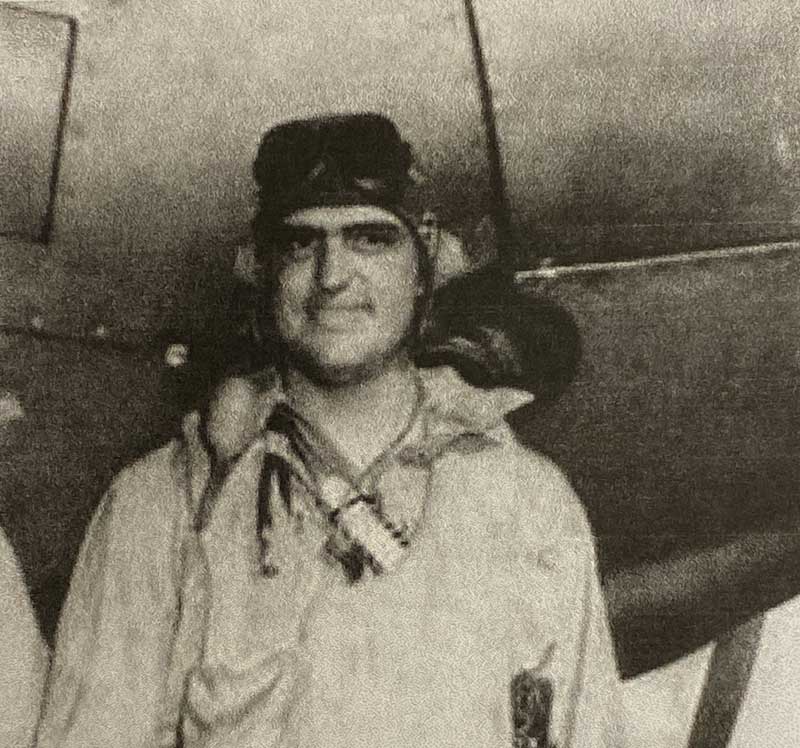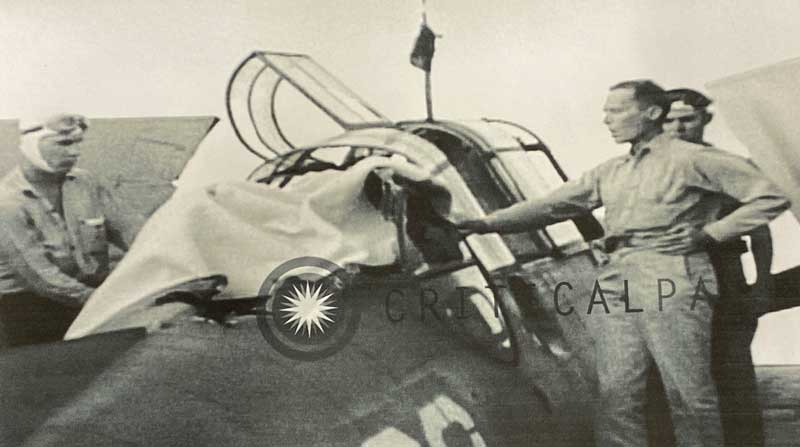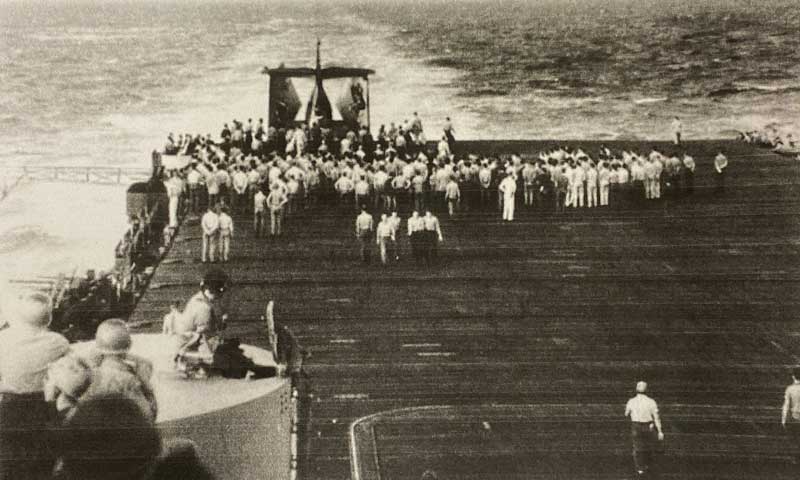What kind of courage does it take to climb into an aircraft during wartime, knowing that as you take your cramped battle station within, it may be the final time you do so? I can only imagine the thoughts that must race through the minds of our military warriors who find themselves in that precarious position, be it on land, on the sea, or in the air, as they prepare to put themselves in harm’s way to battle an enemy who is determined to kill them. Only God knows how many people generally throughout world history, and how many Americans specifically, have faced that life or death question as they resolutely determined to face the enemies of freedom, tamping down their fear as they pondered whether or not they’d ever return home.
Many members of “The Greatest Generation” never returned home. Many of us had relatives who fought in WW11 and never returned. My own wife was one of them. Her father’s younger brother, a WW11 P-40 fighter pilot, was killed in a B-25 crash in Greenland in 1943, as he “hitched a ride” on his way back to the States. He never came home, and neither did his body. All she has is a letter of condolence signed by President Franklin Roosevelt. Many of our country’s warriors lie in far-flung cemeteries, most of them lovingly maintained by people who weren’t even born when they were buried, and “Taps” was played over their coffins. Some of them were buried where they fell, and their final resting places are known but to God. Some of them were buried at sea, wrapped in the traditional shroud. But one of them, the subject of this article, was “buried at sea” in a most unusual shroud and coffin.
Back in “prehistoric times”, as my grandkids love to remind me (actually in the wonderful year of 1952), the great, award-winning documentary, Victory At Sea, was first broadcast on TV. I recall watching every episode, and I’ve since purchased the DVD that contains all of them, and I have watched it again. The years of WW11 were perhaps the last time that all Americans were truly united as one people, and the stories of the valor of our fighting men and women, particularly the warriors who battled their enemy at sea, will live as long as there are Americans who determine that history shall not be forgotten, as so many of our modern-day progressives seem to desire.
One of the “V.A.S.” episodes was titled, “The Conquest of Micronesia”, which showed what was all-too-common during these war years (1941-1945)-- scenes of very moving and solemn burials at sea. The last scene of this episode featured a very sad sea burial, perhaps the most dramatic and touching one ever filmed on a U.S. Navy warship during WW11. The people who lived and fought to victory during that vicious war have not been called The Greatest Generation without reason. This final scene showed a Navy Airman, killed in battle with the Japanese, being buried at sea IN the same aircraft wherein he died battling his country’s enemies. His plane, a Grumman TBF Avenger torpedo bomber, was damaged so severely after being hit by several 40 mm. anti-aircraft shells fired at it by a Japanese cruiser in Manila Bay, that the Navy determined that they would leave his body in what remained of his rear machine gun turret that had been almost totally destroyed, and commit his body and his aircraft to the deep.
To further honor this brave warrior, the Navy declined to strip the badly damaged Avenger for spare parts, which were greatly needed in 1944. This brave warrior is the ONLY known member of the U.S. Navy to be purposely buried with, and inside, his plane, still at his battle station. This documentary’s episode didn’t mention this sailor’s name or the name of his aircraft carrier. But that information is now available for all of us to know and honor this valiant young warrior.
LOYCE E. DEEN, AVIATION MACHINISTS’S MATE 2nd CLASS

Loyce Edward Deen (1921-1944) was only 23 when he gave his life for his country. Loyce was from Altus, Oklahoma and was killed in battle as a part of the noted VT-15 Squadron that was stationed on the historic aircraft carrier, USS ESSEX (CV-9). Even as a teen, he had dreamed of joining the U.S. Navy, and enlisted in October of 1942. He completed his basic training in San Diego and was then sent to Purcell, Oklahoma for Gunnery school, where he learned how to become an expert on his Grumman Avenger’s rear machine gun turret. Avengers carried a commissioned officer as a pilot, a non-com as radioman and the one who armed the bombs or torpedoes (and who also fired a machine gun mounted under the rear of the aircraft), and a non-com rear top turret gunner, which was Loyce Deen’s position.
Deen was assigned to the new 15th Air Group in Sept. of 1943, where he teamed up with his pilot, Lt. Robert Cosgrove (1919-2005) and his Radioman, Donald Denzek (1924-1975), the crew he most often flew with. They became a part of the 15th Air Group (VT-15) in Sept. 1943, and were first assigned to USS Hornet in Feb. 1944. VT-15 was then transferred to USS Essex in April, 1944 at Pearl Harbor.
I’m indebted to Faye Higbee, writing in History on July 27, 2017 for the following account of this brave warrior’s last day, and I quote freely from her article. On Nov 5, 1944, reveille sounded, as usual, at 0530 aboard USS Essex. Breakfast was served an hour later, then all the aircraft crews (bombing and torpedo) assembled for mission briefings. This day’s briefing would be the last one of AMM2 Loyce Deen’s short
life. Lt. Cosgrove, Denzek, and Deen were assigned to attack Japanese ships in Manila Bay, The Philippines. Military vessels would be their prime targets, particularly Japanese cruisers. Cosgrove’s aircraft was assigned tail No. 93. VT-15 took off mid-morning from the Essex. It would require about two hours for these Avenger torpedo bombers to get to their targets. I’m certain that, as they launched from Essex, their hearts were pumping rapidly, pushing increased amounts of “battle adrenalin” into their veins.
When they reached their targets in Manila Bay and began to attack the enemy ships, VT-15 encountered very dense anti-aircraft fire from one of the enemy cruisers. 40 mm. anti-aircraft shells began to explode all around them, and Lt. Cosgrove’s #93 was severely damaged by the Japanese fire. Sadly, Loyce Deen was suddenly “hit bad”, as Denzek told Cosgrove, having been almost decapitated by the shells as they destroyed his machine gun turret, killing him instantly. Lt. Cosgrove’s Avenger had been badly damaged and was almost unflyable. The controls were damaged, and it took all of his strength and piloting skills to get his crippled plane through two bad thunderstorms and extreme mechanical problems to land, two hours later, back on the deck of USS Essex. Since much of the rear turret was blasted away, and the rest of the aircraft badly damaged, it was decided to leave Airman Deen inside his turret. The video shows Navy personnel taking Deen’s fingerprints and cutting off his dog tags. His body was so badly mangled that removing it would have been very difficult, so it was decided by Captain Carlos Wieber, Commander of the Essex, to leave Deen in his aircraft and bury him at sea in it.

Many from the Essex’s crew assembled on the rear flight deck. The Chaplain of the Essex gave a brief service over Deen’s shrouded remains, and then #93, with Deen still at his battle station, was pushed over the back of the deck. As it disappeared under the waves, two Avengers from Essex did a fly over as a salute. I recall seeing, sometime in the past, a photo of a British War Memorial, with what I believe to be an appropriate inscription to honor this brave young man, dead now these 76 years: “When you go home, tell them of us and say for their tomorrow, we gave our today.” Indeed, they did. R.I.P, noble patriot and valiant warrior. Your countrymen honor your sacrifice. We will remember you!
